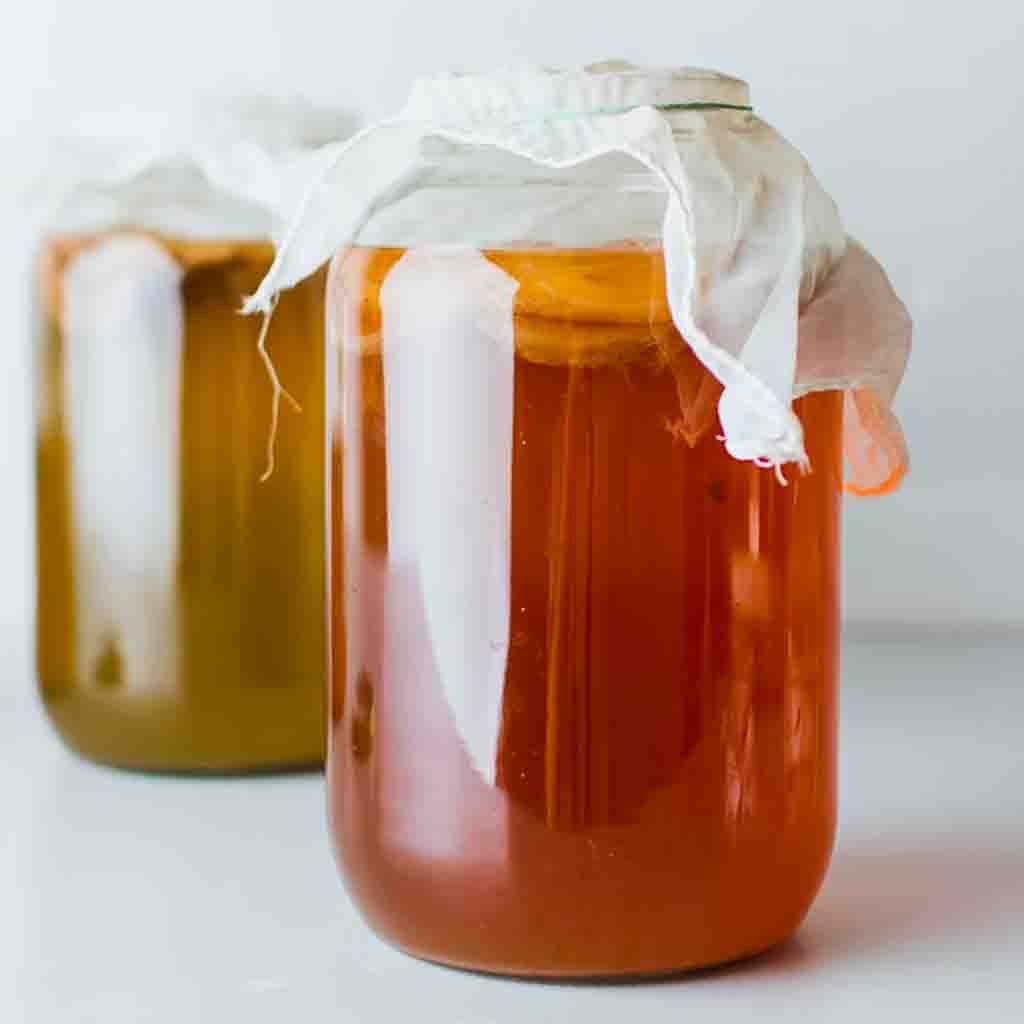
Delicious & Easy
Homemade Sauerkraut
Homemade Sauerkraut
Sauerkraut in its simplest form is fermented cabbage that has been submerged in liquid to deprive it of air and oxygen.
If you were to leave a cabbage on a plate on the counter for a couple of weeks, moulds, which are aerobic (need the air) would develop and eventually rot the cabbage into a slimy puddle.
The process of making crunchy, tangy sauerkraut is completely different. By submerging the cabbage in liquid and creating an anaerobic (no air) environment, the moulds do not develop (as they need contact with air), and instead, beneficial acidifying bacteria take over and ferment the cabbage into a deliciously crunchy sauerkraut full of beneficial live and active cultures.
Fermenting vegetables in order to preserve them, is a practice that has been around for centuries - I imagine so that they could be enjoyed in the months where there was no harvest and fresh vegetables weren’t available.
What Happens During The Sauerkraut Ferment?
Lactic acid bacteria - mostly the Leuconostoc species, are naturally present on the leaves of the cabbage (and most other organic vegetables).
In an anaerobic (no air) environment (which you will create by submerging the chopped cabbage in its own juices), these bacteria produce carbon dioxide and lactic acid.
The liquid soon becomes too acidic for these bacteria to survive, and so they die out and are replaced with different kinds of bacteria that can better handle the acidic conditions such as the Lactobacillus species.
The Lactobacillus ferment any remaining sugar from the cabbage, which produces more lactic acid and further reduces the pH of the liquid.
Cabbage Sauerkraut Recipe
All you need is non-iodised salt, a cabbage and a jar!
There are endless combinations and recipes containing different vegetables (and some fruits) to produce completely different flavours.
I thought I would start with my personal favourite, which is a mix of cabbage, beetroot and ginger. However, you can substitute the beetroot and ginger for your favourites – just aim to keep the ratio of salt to vegetables the same as below.
Equipment Required for Cabbage Sauerkraut
- 1 organic green / pointed cabbage
- 2 organic beetroot heads, peel the skin off
- 2-4cm organic ginger, peeled and grated
- 1 tbsp non-iodised salt for every 800g of vegetables
- 1 litre jar (ideally wide mouthed to make it easy to pack in the veg)
We sell the Kilner 1 litre pack of 2 fermentation jars (glass weights included) and the Kilner Fermentation Set (airlock and ceramic weight included) if you are looking to purchase a complete kit.
Cabbage Sauerkraut Method
- Peel the outside leaves of the cabbage and put aside – you’ll need these later.
- Finely chop the cabbage and beetroot – I personally like to slice the vegetables fairly finely and I also like to keep the width of the veggies approximately the same, so that they ferment at the same speed. However, experiment yourself with different slices and find out what you like.
- Grate the ginger.
- Add 1 tbsp salt per 800g veggies. It is a great idea to weigh your veggies the first few times that you make a batch of sauerkraut, so that you hit the right ratio to create the best environment for the lactic acid bacteria to thrive.
- With clean hands, mix everything together with your hands in a bowl, cover and leave for 1-3 hours on the side so that the salt starts to pull the liquid out of the vegetables through osmosis. This liquid is a crucial part of the ferment as the vegetables will be submerged under their own juices in the jar.
- Now you’ll need to massage the veggies for 5 minutes or so. The aim is to extract the liquid. Very soon you’ll have a lovely pool of purple liquid in the bowl.
- Sterilise a jar and lid – in boiling water ideally
- Take handfuls of the veggies, squeeze out the liquid (but keep this in the bowl) and place into the sterilised jar. Keep going until you are about 3 cm from the top.
- Pack the veggies down tightly – use your fist – with the aim of trying to remove all of the air pockets trapped between the veg.
- Place the cabbage leaf over the veggies and use a weight – the top of a carrot, a sterilised paper weight etc to hold the cabbage leaf down. Getting the veg submerged is THE most critical factor for success in vegetable fermentation.
- Pour the liquid over the top and then loosely place the lid on top. Place the jar on a plate as some liquid will escape.
- It is important to make sure there aren’t any bits of vegetables on the top of the jar or at the side. All of the sliced veggies must be covered with the liquid. You are creating an anaerobic environment, an airless environment, where the lactic acid bacteria thrive and aerobic (needing air) moulds, yeasts and harmful bacteria cannot survive.
- Put the lid on loosely (don’t screw it on) as the veggies will start to ferment and produce a gas. The gas needs to escape. If you screw the lid on tightly the bottle could explode in 24 hours or so! You’ll often find that the juices in the first 24/48 hours rise up and leak out of the jar – this is completely normal. I always place my jar on a plate to catch the liquid.
- Cover the jar with a tea towel and leave on the counter.
- Burp the jar every 12 hours or so for the first couple of days – just lift the lid slightly to let the gas out and then loosely pop back on. You will know when to stop burping so much because you won’t hear the gas escape any more when you open the lid.
- Taste a little after a few days – it will have begun to ferment but you won’t be at the sweet spot yet. Taste some again after a week, and then another week. You will soon find out how long it takes to taste just how you like it. I start eating mine after about 4-12 weeks.
- Once you feel that the crunch and tang of your sauerkraut is just right, pop the jar in the fridge to slow fermentation. It will keep in the fridge for a very long time- I have some that has been in the fridge for just over 12 months tastes fantastic! As long as the veg are completely submerged in the liquid and there are no signs of mould or bacteria, then it will be fine.
- If you see any signs of mould, do not eat. Mould is usually caused because air has got into it - the vegetables may not have been completely covered in the liquid.
- Tuck in and enjoy a spoonful with each meal! Start with a teaspoon and build up gradually so that your body gets used to the influx of great bacteria!
Troubleshooting Homemade Sauerkraut
My sauerkraut has developed a beige surface yeast.
Kahm yeast is harmless. It is beige with a texture like waves. Skim it off as soon as you notice it and continue the ferment. If the vegetables underneath the yeast near the surface have been softened by the yeast, remove and discard these.
My sauerkraut is mushy, not crunchy.
It is likely that it has been fermented for too long, or too little salt was used. You can still eat mushy sauerkraut.
Other Ferment Guides

Komboucha
The SCOBY looks like something you wouldn’t normally go near, let alone have in your kitchen! But it is a magical, living thing that will provide you with endless kombucha if you look after it.

Kimchi
This Korean staple is so easy to make. And once you've made it, you'll wonder how you ever did without it (or paid so much to buy it from the shop!).
